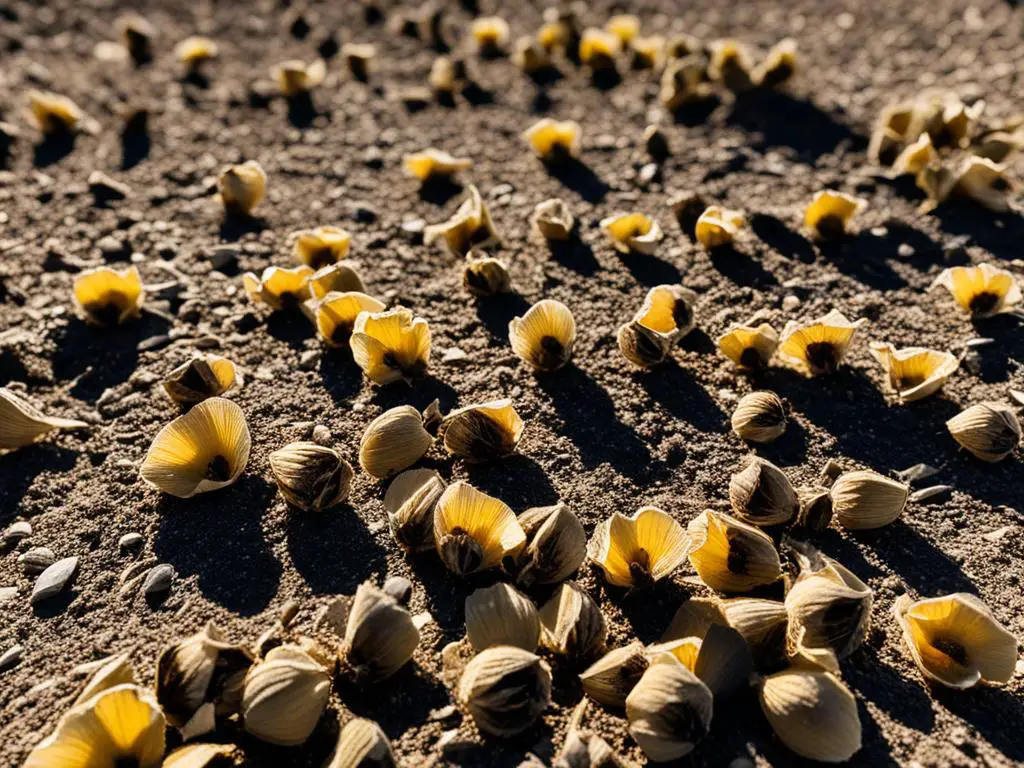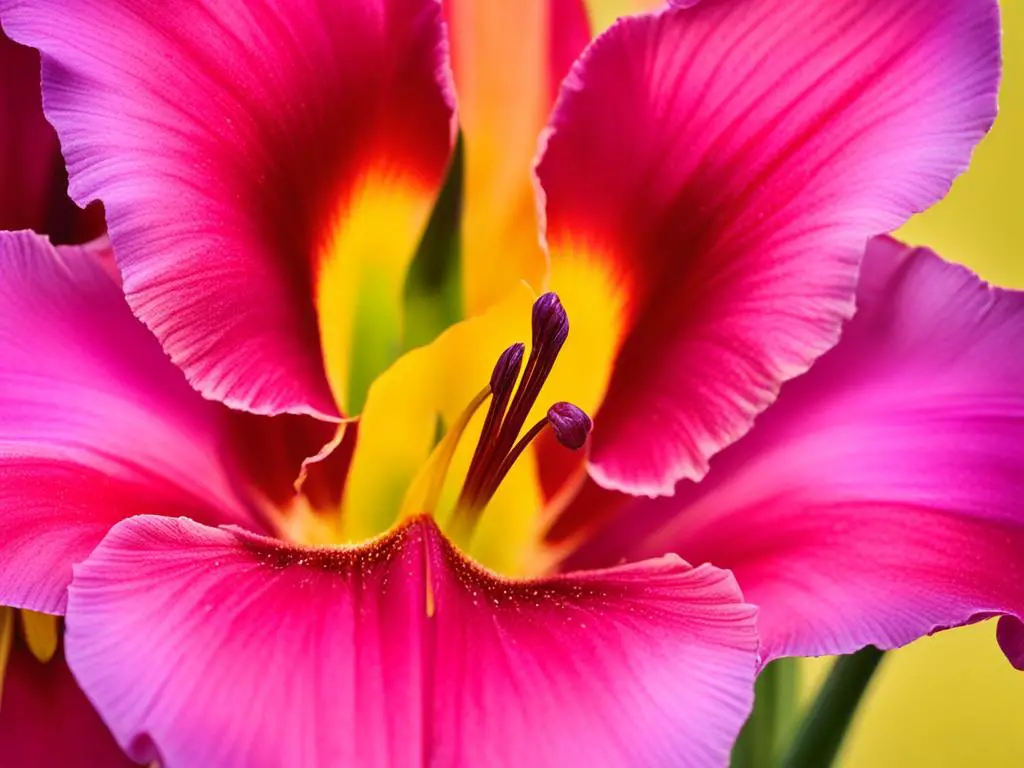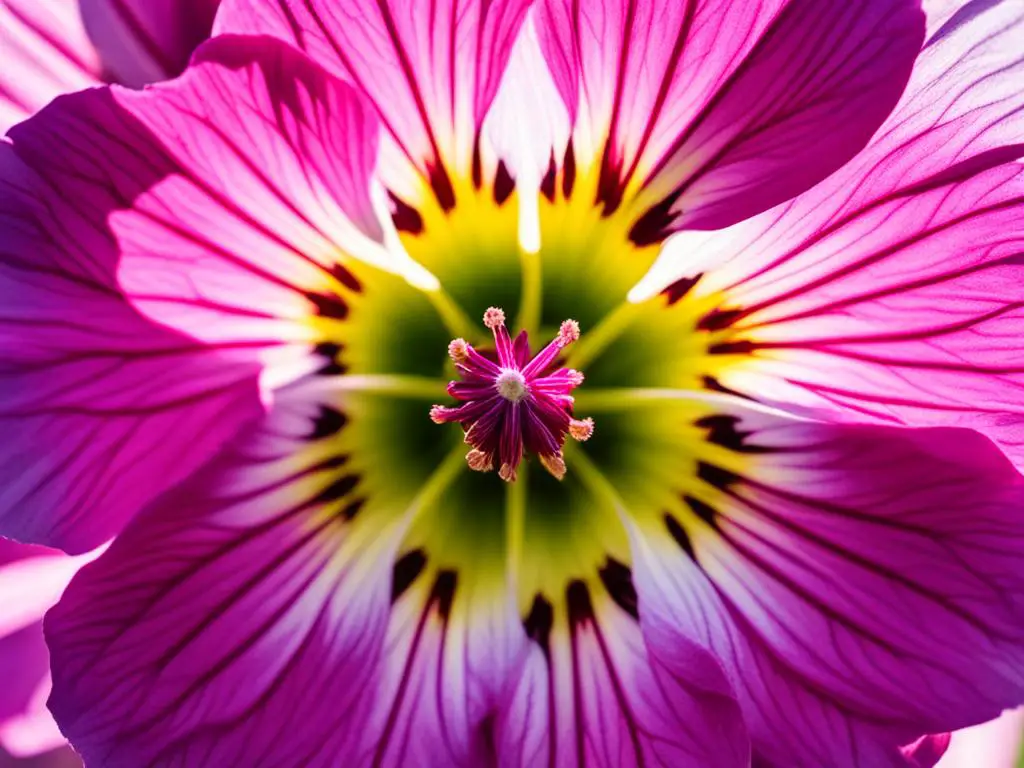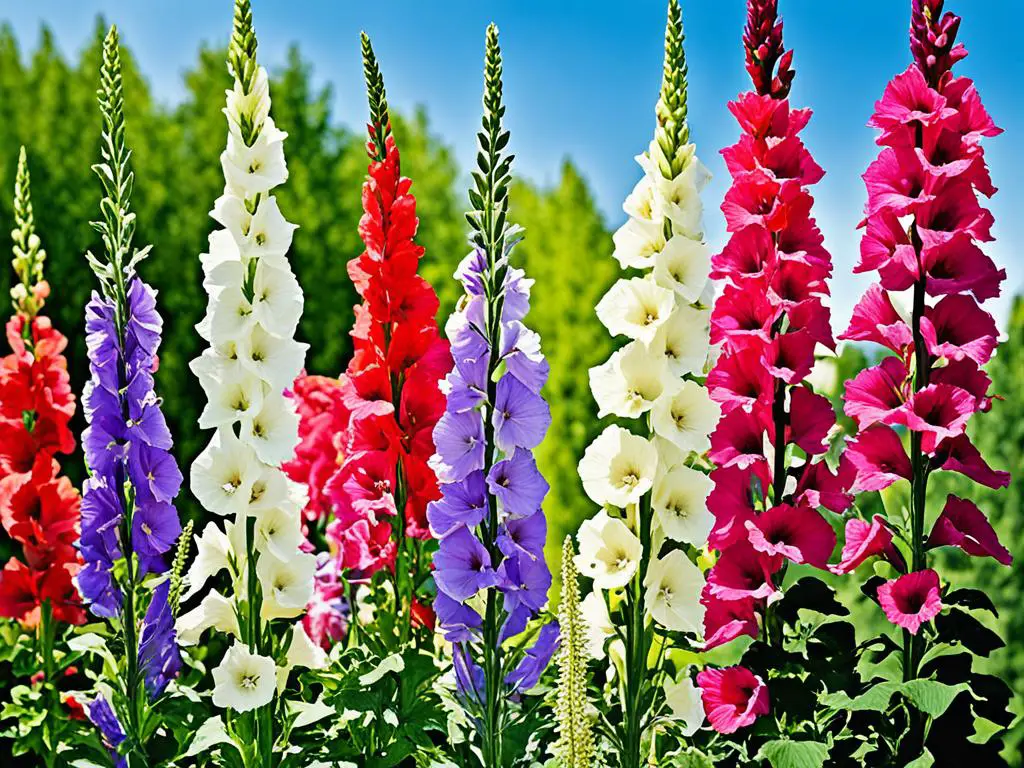Hollyhocks and gladiolus are two stunning garden flowers that are often compared. Let’s take a closer look at the characteristics and care requirements of each to determine which one is the best fit for your garden.
Key Takeaways:
- Hollyhocks and gladiolus are popular garden flowers that offer beauty and color.
- Hollyhocks are versatile and hardy, with tall stems and large leaves.
- Gladiolus blooms in late summer, adding vibrant colors to the garden.
- Hollyhocks have edible and medicinal uses, while gladiolus is mainly ornamental.
- The choice between the two depends on personal preferences and garden needs.
Hollyhock: A Versatile and Hardy Beauty
Hollyhocks are not just weeds, they are actually a versatile and hardy plant that can add beauty to any garden. These stunning flowers can be grown from seeds and come in a plethora of colors, making them a popular choice among garden enthusiasts. With their tall stems and large leaves, hollyhocks command attention and create a grand presence in any outdoor space.
One creative way to engage with hollyhocks is by making hollyhock dolls. Children can have tremendous fun crafting these dolls using the flower blossoms as skirts and the stems as the doll’s body. It’s an activity that allows both kids and adults to appreciate the beauty and versatility of hollyhocks.
Hollyhocks are also known for their resilience and ability to thrive in challenging conditions. They are drought-resistant and can withstand poor and hard soils, making them suitable for a wide range of gardens. Whether you have a dry and arid backyard or a patchy and rocky soil, hollyhocks can be a perfect addition to your garden.
Hollyhock Colors
- Red
- Pink
- White
- Yellow
- Purple
- Black
These are just a few examples of the vibrant hollyhock colors available, giving you endless possibilities to play with when designing your garden.
Hollyhock Height
Hollyhocks can grow to impressive heights, adding vertical interest to your garden. On average, their height ranges from 4 to 8 feet, depending on the variety and growing conditions. Their tall stature makes them perfect for creating focal points or adding a touch of elegance to the background of your garden.
If you are looking for a flower that can endure various growing challenges and still provide a stunning display of colors and height, hollyhocks are an excellent choice. These hardy beauties will effortlessly enhance the visual appeal of your garden.

| Feature | Description |
|---|---|
| Care Level | Low maintenance |
| Hardiness | Resistant to drought and various soil conditions |
| Blooming Season | Summer |
| Watering Needs | Minimal watering required once established |
Now that you know more about hollyhocks and their remarkable characteristics, you can confidently incorporate these versatile and hardy beauties into your garden.
Gladiolus: A Pop of Color in Late Summer
When it comes to adding a stunning burst of color to your late summer garden, gladiolus is an excellent choice. Known for its vibrant blooms, gladiolus varieties come in a wide range of hues, allowing you to create a visually captivating display. Whether you prefer soft pastels or bold and vibrant shades, there is a gladiolus flower that will suit your taste.
Growing gladiolus is relatively easy, as they are cultivated from bulbs. These bulbs can be planted in the spring, so you can enjoy their magnificent blooms later in the summer. It’s essential to select a well-drained soil for planting, as gladiolus bulbs will not thrive in waterlogged conditions. Regular watering is necessary to ensure healthy growth and to help these beautiful flowers reach their full potential.
Impressive Height and Striking Flower Spikes
One of the standout features of gladiolus plants is their impressive height. With their tall flower spikes, gladiolus can reach heights that truly command attention. These towering stems make them an excellent choice for creating dramatic focal points in your garden or for adding vertical interest to your flower beds.
Additionally, gladiolus flower spikes can be a source of beautiful cut flowers for indoor arrangements. Their striking presence and long-lasting blooms make them a popular choice for floral displays and bouquets.
Gladiolus Varieties
With a wide array of gladiolus varieties available, you have the opportunity to explore different colors, shapes, and sizes. From classic favorites like ‘White Friendship’ and ‘Rose Supreme’ to unique cultivars like ‘Black Jack’ and ‘Green Star’, there is a gladiolus variety to suit every taste and garden aesthetic.
To give you a glimpse of the stunning diversity of gladiolus, here is a table showcasing a selection of popular varieties:
| Variety | Color | Height |
|---|---|---|
| White Friendship | White | 3-4 feet |
| Pretty in Pink | Pink | 3-4 feet |
| Violetta | Purple | 4-5 feet |
| Green Star | Green | 3-4 feet |
Remember that this is just a glimpse of the countless gladiolus varieties available. By exploring different cultivars, you can create a dynamic and captivating gladiolus collection that will bring joy and beauty to your garden.

Edible and Medicinal Uses of Hollyhock
Did you know that hollyhock is not just a beautiful flower, but it is also completely edible? All parts of the hollyhock plant, including the leaves, roots, flowers, and seeds, can be consumed. Hollyhock is also a valuable medicinal plant and can be used in homemade skincare products. It is even related to the herb marshmallow and can be used interchangeably. Hollyhock has many versatile uses beyond its aesthetic appeal.
Edible Uses
The hollyhock plant offers a range of culinary possibilities. The leaves of hollyhock can be used as a nutritious addition to salads, soups, and stir-fries. They have a slightly tangy flavor, which adds a unique twist to your dishes. The flowers, with their vibrant colors, can be used as a garnish or infused into syrups, jellies, or even brewed into a delightful floral tea.
“The hollyhock leaves add a wonderful crunch to summer salads and are packed with vitamins and minerals.”
In addition to the leaves and flowers, hollyhock seeds can be roasted and ground into a powder to add flavor to baked goods, such as muffins or bread. The roots of the hollyhock plant can also be boiled and used as a substitute for root vegetables like parsnips or potatoes.
Medicinal Uses
Hollyhock has been used for centuries as a medicinal herb due to its various therapeutic properties. The plant is known for its soothing and anti-inflammatory effects. Here are some common medicinal uses of hollyhock:
- Respiratory Health: Hollyhock can help relieve respiratory issues such as cough, cold, and even asthma. A warm hollyhock tea can alleviate throat irritation, reduce mucus, and ease breathing discomfort.
- Skincare: The high mucilage content in hollyhock makes it ideal for soothing skin conditions like sunburn, rashes, and minor irritations. It can be used topically as a poultice, infused oil, or added to homemade skincare products.
- Digestive Aid: Hollyhock tea has been traditionally used to alleviate digestive issues, including indigestion, stomach ulcers, and constipation. Its gentle, demulcent properties can help soothe and protect the digestive tract.
Hollyhock shares several medicinal properties with its botanical cousin, marshmallow. Both contain mucilage, which forms a gel-like substance when mixed with water, providing soothing and healing effects on various parts of the body, internally and externally.

Comparison: Hollyhock vs Delphinium
To further understand the unique qualities of hollyhock, let’s compare it to another garden flower, delphinium. While both flowers are visually striking and add a touch of elegance to any garden, they have distinct characteristics and uses:
| Hollyhock | Delphinium |
|---|---|
| Edible leaves, flowers, roots, and seeds | Non-edible |
| Used in skincare and medicinal products | No known medicinal uses |
| Tall stems and large leaves | Tall flower spikes with palmate leaves |
| Multiple color options | Wide variety of colors |
| Drought-resistant | Requires regular watering |
Hollyhock in the Kitchen and as a Healing Herb
Hollyhock is not just a beautiful flower for your garden, but it also has culinary and medicinal uses. Here are some ways you can incorporate hollyhock into your kitchen and benefit from its healing properties:
Culinary Uses of Hollyhock
Did you know that hollyhock leaves can be used as a substitute for spinach in cooking? They have a mild, slightly tangy flavor that adds a unique touch to dishes. You can use hollyhock leaves in salads, soups, stir-fries, or steamed as a side dish. They provide a nutritional boost and a vibrant green color to your meals.
“I love adding hollyhock leaves to my summer salads for their beautiful color and delicate taste,” says Amanda, a passionate gardener and home cook.
“Hollyhock leaves have a slightly sour taste and a tender texture. They are a great addition to stir-fries and pasta dishes,” recommends Chef Lisa, a culinary expert.
Medicinal Uses of Hollyhock
Hollyhock has long been used in traditional medicine for its healing properties. One of the most common ways to benefit from hollyhock’s medicinal properties is by making a cold-infused tea. Simply steep hollyhock flowers in cold water overnight, strain, and enjoy a soothing and refreshing drink.
Hollyhock tea is known to help alleviate respiratory issues, such as cough, sore throat, and congestion. It can also provide relief from stomach problems, urinary tract inflammation, and even help with skin conditions like chapped skin, splinters, and painful swellings.
Emma, a herbalist and hollyhock enthusiast, shares her knowledge: “Hollyhock tea is a natural remedy that can help soothe various ailments. Its anti-inflammatory properties make it a popular choice for respiratory and digestive issues.”
If you prefer topical applications, hollyhock leaves can also be made into a poultice. Simply crush fresh hollyhock leaves and apply them to the affected area. The poultice can help reduce inflammation and promote healing.
Hollyhock in a Nutshell
From the kitchen to medicinal remedies, hollyhock is a versatile plant that offers more than just its beautiful blooms. Whether you’re adding hollyhock leaves to your culinary creations or using them as a healing herb, this plant proves to be a valuable addition to your garden and daily life.
| Hollyhock in the Kitchen | Medicinal Uses of Hollyhock |
|---|---|
|
|
Conclusion
In conclusion, both hollyhocks and gladiolus are stunning garden flowers that can add beauty and color to any landscape. Hollyhocks are known for their versatility and hardiness, thriving in various soil conditions and requiring minimal care. They can be grown from seeds, offering a wide range of colors to choose from. Hollyhocks also have edible and medicinal uses, making them a valuable addition to any garden.
On the other hand, gladiolus is a popular choice for late summer gardens, with its vibrant and showy blooms. It is planted from bulbs and comes in a variety of sizes and colors. Gladiolus plants can reach impressive heights, creating an eye-catching display in the garden. They require regular watering and well-drained soil for optimal growth.
The choice between hollyhocks and gladiolus ultimately depends on personal preferences and the specific needs of your garden. If you’re looking for a versatile and low-maintenance flower with edible and medicinal uses, hollyhocks are a great choice. If you want a burst of color in your garden during the late summer months, gladiolus is the perfect option. Regardless of your choice, both flowers will undoubtedly enhance the beauty of your outdoor space. Happy gardening!
FAQ
Are hollyhocks and gladiolus easy to care for?
Both hollyhocks and gladiolus are relatively low-maintenance plants. Hollyhocks are hardy and drought-resistant, while gladiolus bulbs require regular watering and well-drained soil.
Can hollyhocks and gladiolus be grown from seeds?
Yes, hollyhocks can be grown from seeds, allowing for a wide variety of colors. Gladiolus, on the other hand, is usually grown from bulbs.
How tall do hollyhocks and gladiolus grow?
Hollyhocks can grow quite tall, reaching heights of 6-8 feet. Gladiolus plants also have tall flower spikes that can reach impressive heights, usually around 4-6 feet.
Do hollyhocks and gladiolus come in different colors?
Yes, both hollyhocks and gladiolus come in a variety of colors, allowing you to choose the ones that best match your garden’s aesthetic.
When should I plant gladiolus bulbs?
Gladiolus bulbs should be planted in the spring for blooming later in the summer.
Are hollyhocks edible?
Yes, hollyhocks are entirely edible. All parts of the plant, including the leaves, roots, flowers, and seeds, can be consumed.
Can hollyhocks be used for medicinal purposes?
Yes, hollyhocks have medicinal uses and can be utilized in homemade skincare products. They can also be used interchangeably with the herb marshmallow.
How can hollyhocks be used in cooking?
Hollyhocks leaves can be used as a spinach substitute in cooking, and the flowers can be added to salads for a pop of color.



